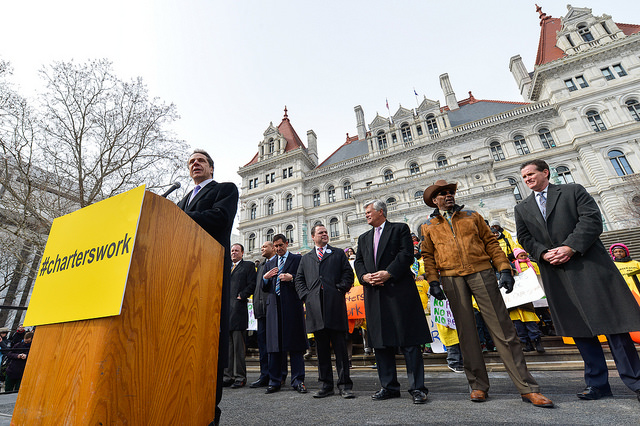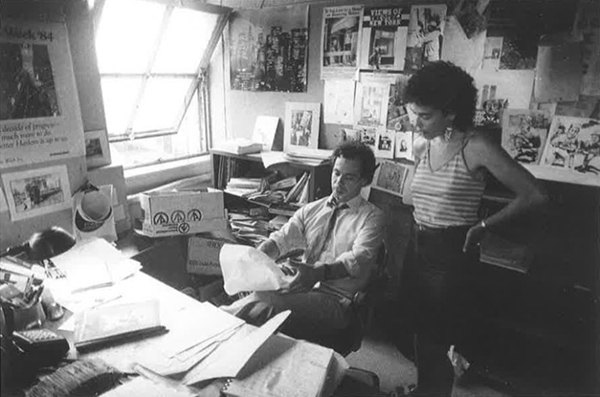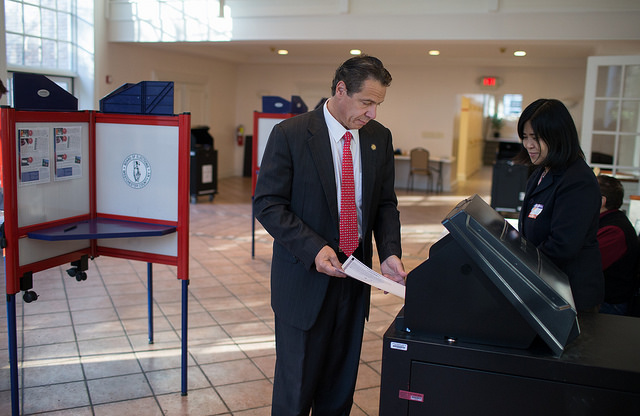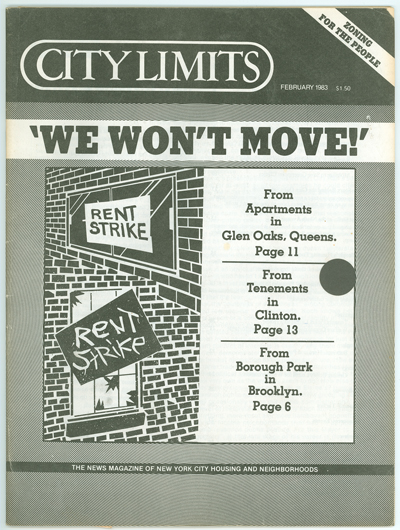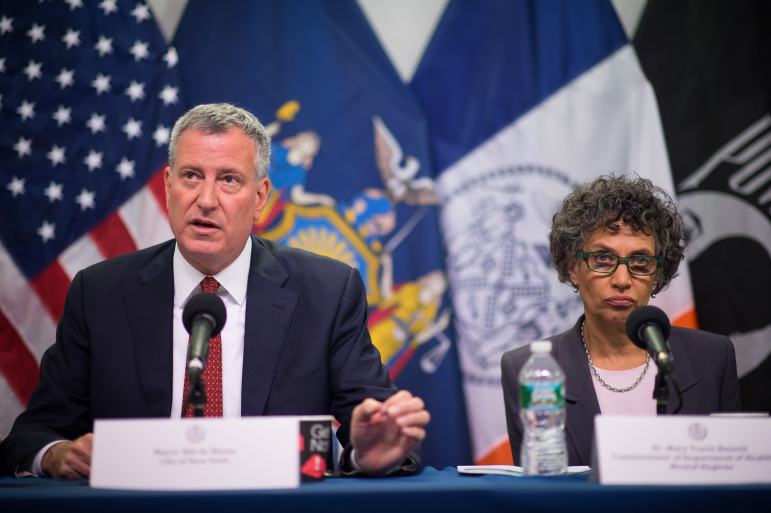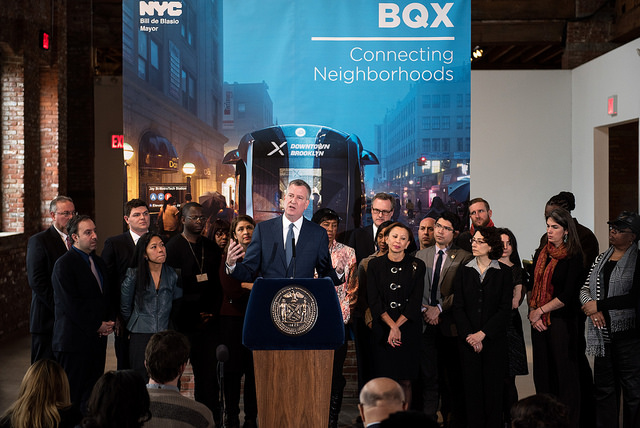
Feburary BQX press conference (photo: Demetrius Freeman/Mayoral Photography Office)
Since Mayor Bill de Blasio announced a proposal for the Brooklyn-Queens Connector (BQX) during his February State of the City address, his administration has marketed the streetcar as a trendy and innovative method of transportation. But to keep the proposed project from becoming just a waterfront tourist attraction, the rationale for the plan has been firmly grounded in its potential to connect working New Yorkers to jobs, both old and new, and cut commute times.
The plan quickly earned the approval of 51 percent of New Yorkers, including 63 percent of low-income New Yorkers, according to a recent city poll by NY1 and Baruch College. Of those polled, 33 percent disapproved of the streetcar plan, while 16 percent didn’t express an opinion.
Keeping New Yorkers, especially those living near the planned route, between Sunset Park and Astoria, involved in the planning process until construction begins in 2019 (or 2020, the administration has not set a firm date yet) will be the next challenge for city officials. Supporters of the project hope to see extensive community outreach that allows residents to play an active role in initial planning stages. The specifics of the plan and its implementation, including the exact route, its effects on traffic and neighborhoods, and construction disruptions, must all be shaped by community input, key stakeholders say.
As with any major infrastructure project, there are sure to be dissenting opinions, and the project already has its share of critics, but key to its success will be the community planning process.
City Council Member Ydanis Rodriguez, chair of the Council’s Committee on Transportation, says residents are a key resource for planning transportation projects and must be treated as such. Rodriguez’s upper Manhattan district is far removed from the planned streetcar route, but he will have some oversight through his committee.
“Residents have on the ground knowledge about everything from walkability to how to get from point A to point B the fastest within the neighborhood,” Rodriguez wrote in an email. “This valuable information can help city planners and the EDC best determine how to overcome challenges and garner increased support and excitement from the community. It creates opportunity for dialogue and a back and forth that is valuable in the long run.”
The de Blasio administration recently ran into some trouble when attempting to win community board support for its citywide rezoning proposals meant to spur affordable housing development. While most community boards disapproved of the plans as they reviewed them, the City Council made adjustments and passed them last week.
Rodriguez thinks the Department of City Planning, Economic Development Corporation (EDC), and Department of Transportation (DOT) - the three city agencies key to the BQX plan - have all improved community outreach efforts in recent years, and should continue to engage residents’ while planning the streetcar.
“Questions should focus on where transportation has been lacking, what connections to existing transit can be most advantageous to riders and what areas are most in need of service,” he said.
Council Member Carlos Menchaca, who represents Sunset Park and Red Hook, pushed for community engagement when he spoke at Mayor de Blasio’s BQX press conference in Red Hook. After unveiling the plan during his State of the City, de Blasio held a more detailed event later in February with Menchaca and other key stakeholders who are supportive of the plan.
 Red Hook Houses, a NYCHA development that has been isolated by lack of sufficient access to public transportation, has been a focus of the streetcar proposal. The BQX could provide transportation to those living in 13 NYCHA developments, home to more than 40,000 people — about 10 percent of the city’s public housing population. Menchaca emphasized the importance of input from all residents, especially the diverse community of public housing residents.
Red Hook Houses, a NYCHA development that has been isolated by lack of sufficient access to public transportation, has been a focus of the streetcar proposal. The BQX could provide transportation to those living in 13 NYCHA developments, home to more than 40,000 people — about 10 percent of the city’s public housing population. Menchaca emphasized the importance of input from all residents, especially the diverse community of public housing residents.
“Experience has taught me community engagement will fail without involving immigrants, youth, and non-English speakers,” he wrote in an email. “Inclusive community engagement is hard work. But it leads to better results and it’s worth the effort.”
To include these groups, Menchaca called for community planning event times that accommodate working people and parents, multilingual outreach efforts, translators at all meetings, and structured public forums that encourage more participation than simple polling methods.
“I’d also like the Mayor’s planning process to address community concerns about the project’s potential to accelerate harmful gentrification and displacement,” he added. The streetcar is expected to raise property values along its route, which is how the administration plans to pay for its projected $2.5 billion cost (using bonds repaid “value capture”). It is also expected that the streetcar will lead to more restaurants, coffee shops, and other amenities along its route, potentially increasing neighborhood costs.
The de Blasio administration plans to start community outreach measures this year before beginning the formal approval process in 2017, followed by the final design stages in 2018. While the mayor is pushing for construction to begin in late 2019, his top officials in charge of the project have been hesitant and cite 2020 as a more realistic start date.
Until then, community involvement in the initial planning could be the most important part of the project, as the effectiveness of outreach measures may dictate both how well the BQX actually meets residents’ transportation needs and how much buy-in the project earns. Meetings with community boards and civic groups will begin in April, followed by larger community meetings starting in May and June and continuing through the summer. By the fall, city officials aim to report specific findings to project stakeholders.
Overseeing BQX is Alicia Glen, de Blasio’s deputy mayor for economic development. City Planning chief Carl Weisbrod, DOT Commissioner Polly Trottenberg, and EDC Commissioner Maria Torres-Springer are all playing key roles.
EDC representatives have already begun to brief elected officials, transit experts, and community advocates, including on expectations for upcoming outreach efforts. Elected officials will be integral in connecting the administration with a wide range of communities and building crowd participation, according to these officials.
After the ongoing initial briefings, EDC plans to organize workshops and open houses in large venues that will allow residents to directly engage with BQX planners. Outside of the public forum setting, EDC will engage residents on the street with interactive planning tools, like through tablets. Residents unable to attend meetings or workshops will be able to participate via web portal.
Resident input on local neighborhood geography along the planned route and nearby it is an important resource for EDC, particularly when navigating plans regarding truck loading, curb regulations, crosswalks, and locations for stops and stations.
The de Blasio administration can also use community outreach as a platform to address concerns about the BQX plan. After the streetcar proposal was announced, critics were outspoken about potential pitfalls, questioning whether improvements to Select Bus Service, Bus Rapid Transit, or subway lines would be more efficient or effective. City officials have maintained that while these were all options for improving connectivity among waterfront neighborhoods and beyond, none of them would stimulate the new development and increase in property value that is expected from the BQX. They also stress that this project won’t preclude others and that streetcars are being utilized around the world as a happy medium between more expensive subways and less interesting buses.
“Bus Rapid Transit tends to go in places that are already developed and that’s why it’s so crowded,” Deputy Mayor Glen said last month on NY1. “Here we’re going to be able to help both existing residents and businesses get connected to each other while also stimulating new development along the corridor in places that can and should accommodate additional development.”
Glen, de Blasio, and others have also said that the BQX is something the city can do on its own, without MTA approval (the MTA is a state authority, controlled by the Governor and his appointed chair.)
Other concerns include subway connections, financing the project, and fare integration. Ben Fried, editor-in-chief of Streetsblog, noted that the proposed route does not include stops near J/M/Z trains and is two to three “long” blocks away from any L train stops. He also questioned the financial plan for BQX’s estimated cost of $2.5 billion.
“The properties the streetcar will serve are already getting developed. (Have you been to the waterfront lately?) The real estate doesn’t need an extra push from a streetcar with poor connections to the subway,” Fried wrote in a Streetsblog post. “If the project is funded by skimming property tax revenue that would have been collected anyway, that’s a plain old subsidy that comes at the cost of other public priorities in the city budget.”
Amid the criticism, the de Blasio administration promoted the BQX with at least five different media releases and the press conference in Red Hook, not to mention multiple appearances by Glen and others on TV and in front of live audiences. The press releases included praise and support from elected officials, CEOs, and others. There are statements from government leaders in other American cities with successful streetcars, like Portland, OR, where a streetcar route provides transportation to almost one-third of the city’s jobs and has stimulated $4.5 billion of new property development.
The proposed route of New York City’s streetcar, estimated to be up and running by 2024, will stretch 16 miles between Astoria and Sunset Park, serving more than 400,000 people in the neighborhoods along the East River, according to city estimates. The mayor’s office projects that commute times between underserved residential areas and employment centers, like Downtown Brooklyn and the Brooklyn Navy Yard, will be shortened significantly, some even cut in half. During his press conference on the subject, Mayor de Blasio estimated that the 20-minute streetcar ride from Red Hook to DUMBO will save commuters an average of five hours per week.
The fare will be pegged to that of a Metrocard ride (currently $2.75), but integration with the MTA fare system is a major question mark that city officials say they are beginning to explore. The BQX will be city-run mass transit, as opposed to the subways and buses run by the state authority. Along with a new ferry system and Citi Bike expansion, de Blasio is making it clear that he is trying to supplement MTA offerings with city-run projects.
To de Blasio, the BQX is not only a project to propel low-income and working-class residents forward as their waterfront neighborhoods continue to develop, but an investment in the future of the city. At the press conference in Red Hook, the mayor noted that the city is stretching its economic centers to include more than Wall Street and Manhattan’s traditional industries. He envisioned the streetcar as key to a burgeoning “five-borough economy” that uses all of New York’s industries, resources, and neighborhoods to their full potential.
“We’re going to make this change to meet the 21st century reality and make this city work better for everyone,” he said. “The next great step towards creating that five-borough economy, towards creating opportunity and addressing income inequality, towards making this extraordinary engine that is the Brooklyn-Queens waterfront all it could be — that next great step is the Brooklyn-Queens Connector.”
But advocates and analysts maintain that the BQX will not be fully advantageous to residents and industries along the waterfront unless community members play an active role throughout the planning process.
“The BQX could be wonderful. I’ve seen street-level rail work well in other settings,” said Council Member Menchaca. “But, at the moment — great renderings notwithstanding — we have what should be the beginning of a conversation with residents, not a finalized plan to which people should merely react.”
***
by Carmen Russo, Gotham Gazette
@GothamGazette @carmenjrusso
